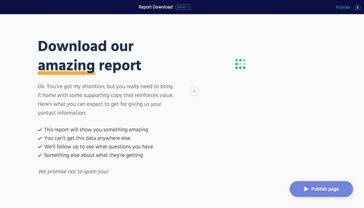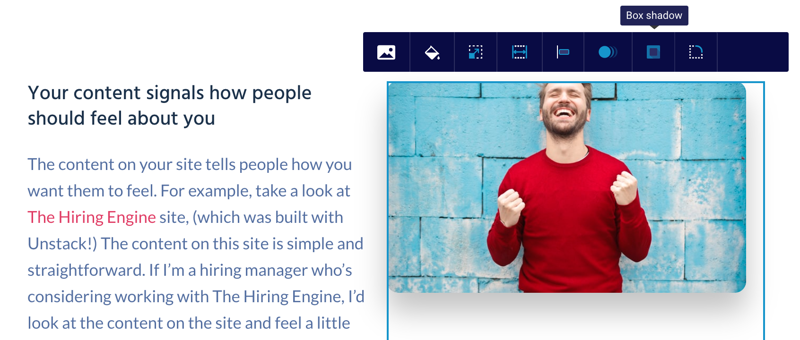In this lesson, we’re going to show you how to build an engaged audience by publishing clear, compelling content. Don’t forget that the content on your site isn’t limited to what’s on your blog. “Content” does include blog posts, of course, but it also includes the images and icons you select, as well as the micro-copy you use on your buttons and landing pages. All of these require consideration if you want to build a loyal audience whose interests align with your business.
The content you publish online shows the world who you are, how you relate to others, and what you value. If you’re a mostly digital brand, this is particularly important, since audience members won’t get a sense of who you are from a storefront, for example. But even if you do engage with customers in the real world, your online persona matters. The perceptions people develop of you online impact how they interact with your company and brand:
Have you ever had one of those experiences where you’re about to buy something online, and you’re stopped dead in your tracks by egregious typos on the payment page? Maybe you find yourself wondering whether their products are shoddily made. Or maybe you question whether they’re capable of giving you the smart advice you need. Whatever the thought process, typos and grainy images erode audience trust quickly. And what’s more, they can stop someone from making a purchase and can reduce your overall conversion rates.
The content on your site tells people how you want them to feel. For example, take a look at The Hiring Engine site, (which was built with Unstack!) The content on this site is simple and straightforward. If I’m a hiring manager who’s considering working with The Hiring Engine, I’d look at the content on the site and feel a little less stressed. The clear language and uncluttered design makes me feel like I’ll be able to tackle my hiring challenges head on. Think about the emotions you want to evoke. Every image, word, and message should underscore what it feels like to work with your company.
Similarly, the content on your site tells people what matters most to you. In our example above, it’s clear that The Hiring Engine values a hassle-free, “no BS” experience. The written content communicates their commitment to a straightforward experience. The images often feature people, so it’s clear they take a people-centric approach to the hiring process. Even the icons near the bottom of the page convey valuable, nuanced information about the industries they serve. Everything you choose to add to your landing page or site reflects your values as an organization.
Let’s dig into the details of building an engaged audience with great content. It boils down to writing honest, compelling copy, selecting the right images and icons, and A/B testing to make sure your content aligns with your audience’s preferences.
Publishing great copy fosters engagement and loyalty. It’ll help your business attract the right customers...and it might even be off-putting to those who are a bad fit. (Note: this is a good thing, since it means you’re not wasting one another’s time!) Great copy will help amplify and elevate everything else you’re doing to build a thriving business.
First, you’ll need to get to know your audience. Maybe you’ve done this already, (and if so, bravo! So many people overlook this critical step.) If not, try carving out time to connect with customers and audience members in whatever way you can, whether it’s in person, on the phone, during sales calls, through your support channel, or on Facebook. Get to know their needs, priorities, and how they perceive your brand.
Next, think about the tone you want to use with them and the experience you want to provide. For example, are you an expert in HR benefits like Compt? If so, you’d probably want to adopt a tone that’s authoritative but friendly. You might decide that you want to create an experience that’s educational and business-oriented but not overly formal.
Write down the tone and experience you want to create, and review this whenever you launch a new landing page or edit a section of your site. As you A/B test different approaches, make sure you document the outcomes of these tests. This will help you refine your site content over time, so that it’s increasingly aligned with your audience’s characteristics and priorities.
Finally, make sure your copy is as clear and compelling as possible. If you’re offering something of value (like a report or white paper,) explain why it’s so valuable. If the data isn’t available anywhere else, let people know. If you plan to follow up with everyone who downloads your report, tell them that too.
Unstack makes this part a bit easier for you. If you use one of our templates, you’ll see specific examples of what to include and where. We’ll give you guidance about how to build trust with your audience. For example, build greater credibility by showcasing customer testimonials in the right places.
Add energy and color to your landing pages with images and icons. We’ve built integrations with some of the most beloved tools out there to make this process easier. Our Unsplash and Icons8 integrations let you search for and implement visuals within seconds. No more messing around with multiple tabs and downloads. And there’s no need to stress about resizing images or securing usage rights.
Spend a little extra time spiffing up your images. For example, round out the edges of a photo by adding a border radius. Another favorite is the box shadow, (as shown below!) which helps your images pop a bit more on the page. Last, consider animating your images, making them slide in as people scroll. Hover over any image to see how the image editing tool can add an extra layer of pizzazz to your pages.
The images and icons you select are nearly as important as the copy you publish. If you choose the right ones, site visitors gain an immediate sense of how you fit their needs. If you choose the wrong ones, you risk people bouncing from your pages shortly after they arrive. Foster audience affinity by testing different images and icons to see what works.
We want to make this process so efficient that testing visual assets is a no-brainer. Ultimately, we know that the more efficient it is to find images, the more likely you are to test things. The more likely you are to test different visual assets, the more likely you are to get useful data about what works for your audience.
Remember: what often differentiates good marketers from great marketers is a willingness to try new things. This willingness, paired with a commitment to measure and then double down on what’s working can give you a meaningful advantage over those who just throw things at the wall in a disorganized way.
Whether you’re working on written copy or selecting visual elements, don’t let the perfect get in the way of the good. If you’re not sure how your audience will respond to a new tagline, put it out there, and find out. It might be game-changing, or it might flop. But you’ll never know if you don’t test it.
Building a landing page and A/B testing the elements that live on it shouldn’t take all day. In fact, we think A/B testing different images should take just a few seconds. We want to make this a regular part of your workflow. With easier testing, everyone can feel empowered to A/B test different copy, images, and icons. The end result? Better marketing, stickier customers, and more feedback about what works for your audience.





